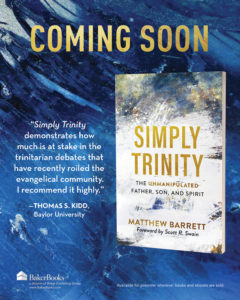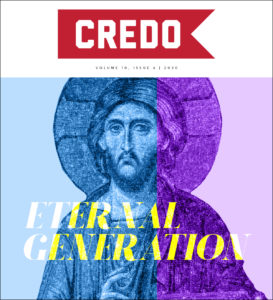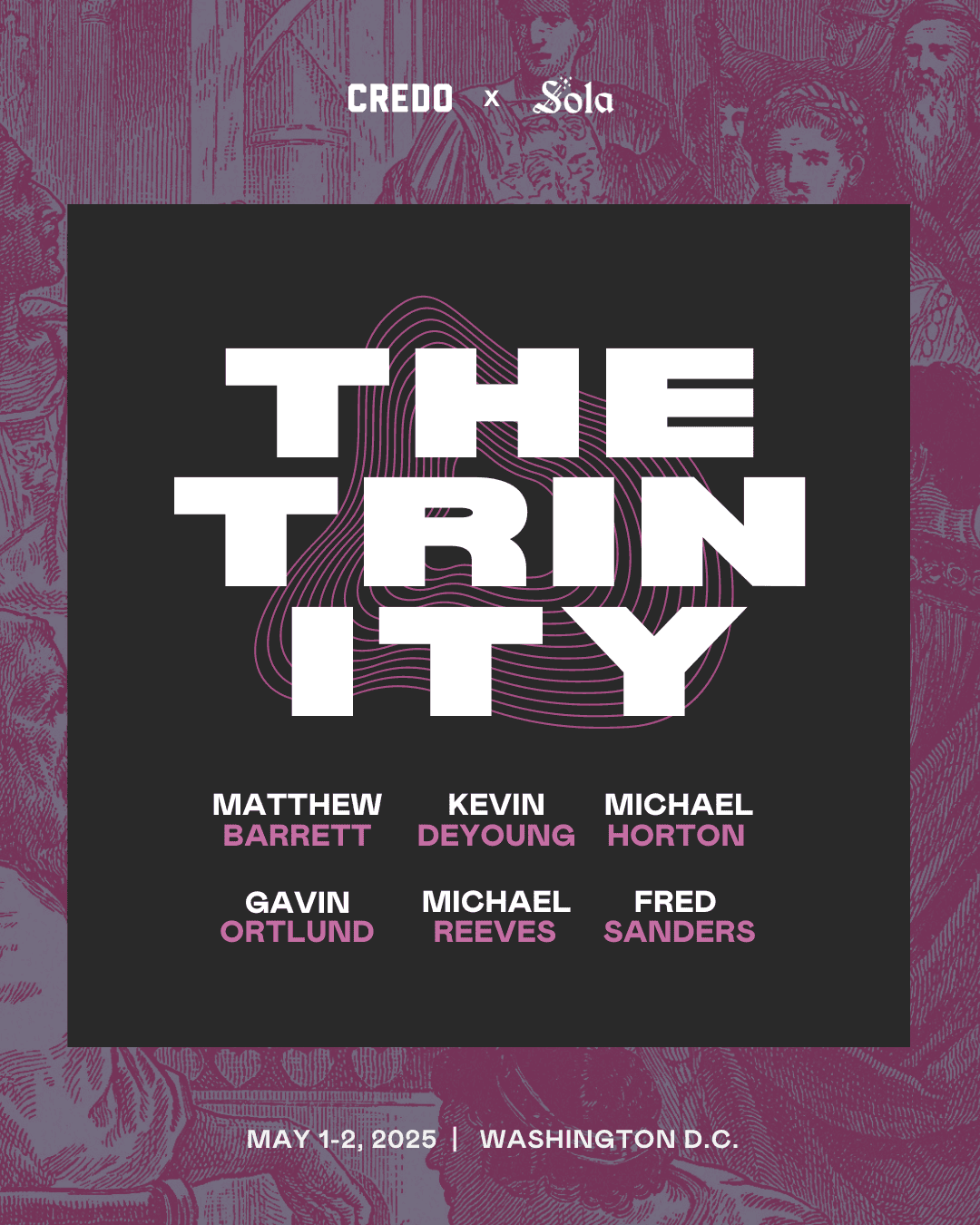I spent the earliest years of my faith holding to the mantra “no creed but the Bible.” I read books about sola Scriptura, and I trusted in my (and my pastors’) abilities to approach the Bible and walk away with the right interpretation through the illumination of the Spirit. We read earnestly, and so God would reward us… At this stage in my faith, I truly believed that my pastors were always right.
Years later as I approached my undergraduate degree, I had a sneaking suspicion that my pastors might not be right about everything, but I worried this was due to my own rebellion. Suddenly, I learned that my professors had different opinions from my pastors, and even different opinions from one another. Each of these godly people also seemed to read earnestly, so who had God rewarded with the right interpretation? Who could I trust? Who was faithful? By the end of my program, I had a fuller understanding. I could distinguish between an essential component of the faith and a distinctive of my denomination. Today I define the essential components of the faith “once for all entrusted to the saints” (Jude 3) as the teachings of the Creeds and Councils. They have been preserved for us by the grace of God, and they provide global unity for all who profess faith in Christ.
The Creed and the Christ
The Creeds can offer this because they are representative of early interpretations of scripture from the first centuries of Christianity. The Creeds do not cite single texts of Scripture, but they seek to synthesize the whole counsel of God. Those who have departed from their teachings and attempted to operate independent of their authority have often failed to consider the relationship among texts of Scripture (e.g., subordinationist readings of 1 Cor. 11:3), sometimes falling prey to egregious proof-texting.
 Turning to our section of the Nicene Creed, we shall see that the Creed is wholly dependent on Scripture, drawing its language and its logic from the Word of God. The true danger of “no creed but the Bible” is when that phrase really means something like “no interpretation but my own.” Our New Testament writers were not ashamed to build upon traditions, and we shouldn’t be either.
Turning to our section of the Nicene Creed, we shall see that the Creed is wholly dependent on Scripture, drawing its language and its logic from the Word of God. The true danger of “no creed but the Bible” is when that phrase really means something like “no interpretation but my own.” Our New Testament writers were not ashamed to build upon traditions, and we shouldn’t be either.
For instance, in 1 Corinthians 15:3–8, Paul summarizes what he “received” and “passed on”—“that Christ died for our sins according to the Scriptures, that he was buried, that he was raised on the third day according to the Scriptures, and that he appeared [to many]…” Paul uses this standard teaching in two ways. First, he “flexes” a bit and reminds the Corinthians that he is one of the apostles who by God’s grace saw the risen Christ, and second, and more importantly for our purposes, he uses this as a starting point for his teaching about bodily resurrection. Most think that Paul is drawing upon a standard early Christian formula here. In other words, Paul was not the first (or only) to summarize the saving work of Jesus in this way. Paul appeals to tradition. The true danger of “no creed but the Bible” is when that phrase really means something like “no interpretation but my own.” Our New Testament writers were not ashamed to build upon traditions, and we shouldn’t be either. Share on X
The tradition that he recounts here is in the form of a narrative, yet Paul (or his precursor) has woven in the theological significance. For example, Christ “died for our sins” and “was raised on the third day”—both “in accordance with the Scriptures.” Those Scriptures—most likely Isaiah 53 and Psalm 16, respectively—imply that Jesus is both Servant and Messiah. From here, the associations and allusions multiply.[2]
Continually, we see that the shape of Jesus’ life, as portrayed by the Gospels, reflects broader theological truths about who he is. I offer this reminder as we turn to this section of the Creed that explicitly offers a narrative summary of the life of Jesus because his life and its significance are indistinguishable. In fact, this section of the Creed builds upon the prior declaration that Jesus is the one Lord, who is the true God and Light begotten from the Father. To say that he is “God from God” is to say that, while he was sent, he is of the same kind as the Sender.[3]
Thus, to be sent is not necessarily to be subordinate. Granted, the Son is not the Father’s first emissary, prophet, or anointed one who speaks on his behalf; God spoke to our ancestors through a number of mediums (Heb. 1:1), and the message they communicated on his behalf was true and good. But their message was limited because the message they offered was mediated. They stood in the image of God, but were not the image of the invisible God themselves (Col. 1:15). The Son is the “radiance of his glory” (Heb. 1:3) or the light that emanates from him. Although a prophet or angel of the Lord might speak for God in such a way that their voices become united, the prophet and the angel always remain a separate entity. This is not so with the Son; they are united in being and will.
In his Prologue, John tells us that, “no one has seen God at any time,” but “the only Son, who is God, being in closest relationship with the Father, has made him known” (Jn. 1:18). The image of the Word offers the best explanation of how the Father is “made known.” The Word communicates on behalf of God, sharing his message to his people, but he also in a sense “communicates” God—who he is.[4] This is possible because he is the Light of the World who is from Light. Of equal glory, even as he dwells in our midst. He is the same yesterday, today, and forever (Heb. 13:8). The Word communicates on behalf of God, sharing his message to his people, but he also in a sense “communicates” God—who he is. Share on X
Mutuality within the Godhead implies a lack of hierarchy, but it does not collapse the distinctions among the persons. These two ideas (hierarchy and distinction) have sometimes become muddled, especially due to a misunderstanding of the language of processions. The Son proceeds (or is eternally generated) from the Father. The Father does not proceed from the Son. For some, this implies, even proves, that the Son is not merely second, but secondary. In other words, his eternal generation implies eternal subordination. But the Sender does nothing without the Sent, and the Sender and the Sent are one in mission, being, and will. Through its depictions of the Father, Son, and Spirit interacting, Scripture reveals the work primarily attributed to each of them. These interactions reflect, through a glass perhaps still dimly lit, more of God’s life in himself. Further, in addition to the depictions of interactions among them, we see clear statements about their unity with one another, such as John 17:11, “Holy Father, protect them by the power of your name, the name you gave me, so that they may be one as we are one.”[5]
Their unity of will is portrayed at several points in the New Testament. While the Father sends him, the Son is willing to offer himself as a sacrifice. This is very clear in Hebrews 10:5-7. Placing the words of Psalm 40:5–7 on the lips of Jesus, “as he enters the world,” the Messiah says, “I have come to do your will, O God.” The Son, as one who is “eternally begotten,” is rightly the one who is sent into the world. But again, this is not evidence of subservience to the Father. The radical message of the Incarnation is that the Son in his humanity submits himself not just to the Father, but to death. Christ in his humanity is made truly low, humiliated, and he chooses that for himself. The Son is sent, but he is not a reluctant child, pressed to obedience by his Father; the Son accepts his mission “because of the joy set before him” (Heb. 12:3). He descends from heaven “for us and for our salvation.”
As one equal to the Father, it is incredible that the Son was tested in every way that we are (Heb. 4:15)—beginning with his time in the womb of Mary. It would be one thing for God to choose to occupy an adult body, but the incarnate Son, in service of becoming human in every way, became dependent upon the body of a woman. She fed him in the womb and then from her breasts. Nevertheless, the Son’s full dependence upon his human mother is not a portrait of weakness, but strength. To relinquish one’s own power and to trust in the power that will raise him, this is true might. Mutuality within the Godhead implies a lack of hierarchy, but it does not collapse the distinctions among the persons. Share on X
Decades later, as depicted in John’s Gospel, Jesus will approach those who come to arrest him, and he will give himself over (Jn. 18:4), a perfect representation of his control and willing submission. He humbles himself, then suffering to the point of death on a cross (Phil. 2:8). He was buried. He fully experiences death, and yet his body does not see decay. Unlike Lazarus in John 11, who is dead for four days, Jesus is only dead for three “in accordance with the Scriptures.”
The Spirit joins the Father and the Son in their work. During his earthly mission, the Son is empowered by the Holy Spirit, as is stated in the Creed. This is another way that we see mutual dependence among the persons. The Spirit empowers the Son, and of course, as “another” Paraklete or Helper, he will continue the Son’s work after the ascension (Jn. 14:16, 26), and yet the Spirit proceeds from the Father and the Son. The Son is second, and the Spirit third, but again, this ordering (taxis) does not require subordination. We see similar indications of mutuality in the depiction of God as “Father.” One cannot be a father without a child. As such, the Son is necessary to the Father’s identification as Father, even though he is “first.”
Judge of all
Throughout this section of the Creed, we have seen the remarkable work of God in the incarnation. The Father who is willing to send his Son, the Spirit who empowers him, and the Son who chooses to be born of Mary and suffer. This section of the Creed ends where it begins—with Jesus in a clear place of authority—but as we have seen, the Son is powerful in his choice to become powerless. The final line of this section of the Creed is another image of strength and of his coordination with the Father. Jesus is depicted as the judge of all.
Endnotes
[1] Many thanks are due to Ross Neir for providing feedback on an earlier draft of this article.
[2] I follow John C. Poirier here in understanding the resurrection “on the third day in accordance with the Scriptures” (in 1 Cor 15:4 and by extension the Creed) to be a reference to Psalm 16:10. See John C. Poirier, “Psalm 16:10 and the Resurrection of Jesus ‘on the Third Day’ (1 Corinthians 15:4),” Journal for the Study of Paul and His Letters 4, no. 2 (2014): 149–67. For the connections between Isaiah 53 and 1 Corinthians 15, see Simon Gathercole, Defending Substitution: An Essay on Atonement in Paul, Acadia Studies in Bible and Theology (Grand Rapids: Baker Academic, 2015), chap. 2.
[3] For more on the relationship between the mission and processions, see Fred R. Sanders, The Triune God, New Studies in Dogmatics (Grand Rapids: Zondervan, 2016), esp. ch. 5.
[4] “The triune God communicates not only information but life and energy as well, through Word and Spirit.” See Kevin J. Vanhoozer, Remythologizing Theology: Divine Action, Passion, and Authorship, Cambridge Studies in Christian Doctrine 18 (Cambridge: Cambridge University Press, 2010), 177.
[5] For more on the Theology (proper) of John, see Andreas J. Köstenberger and Scott R. Swain, Father, Son and Spirit: The Trinity and John’s Gospel, NSBT (Downers Grove, IL: IVP Academic, 2008); see also Andrew J. Byers, Ecclesiology and Theosis in the Gospel of John, SNTSMS 166 (Cambridge: Cambridge University Press, 2017).


